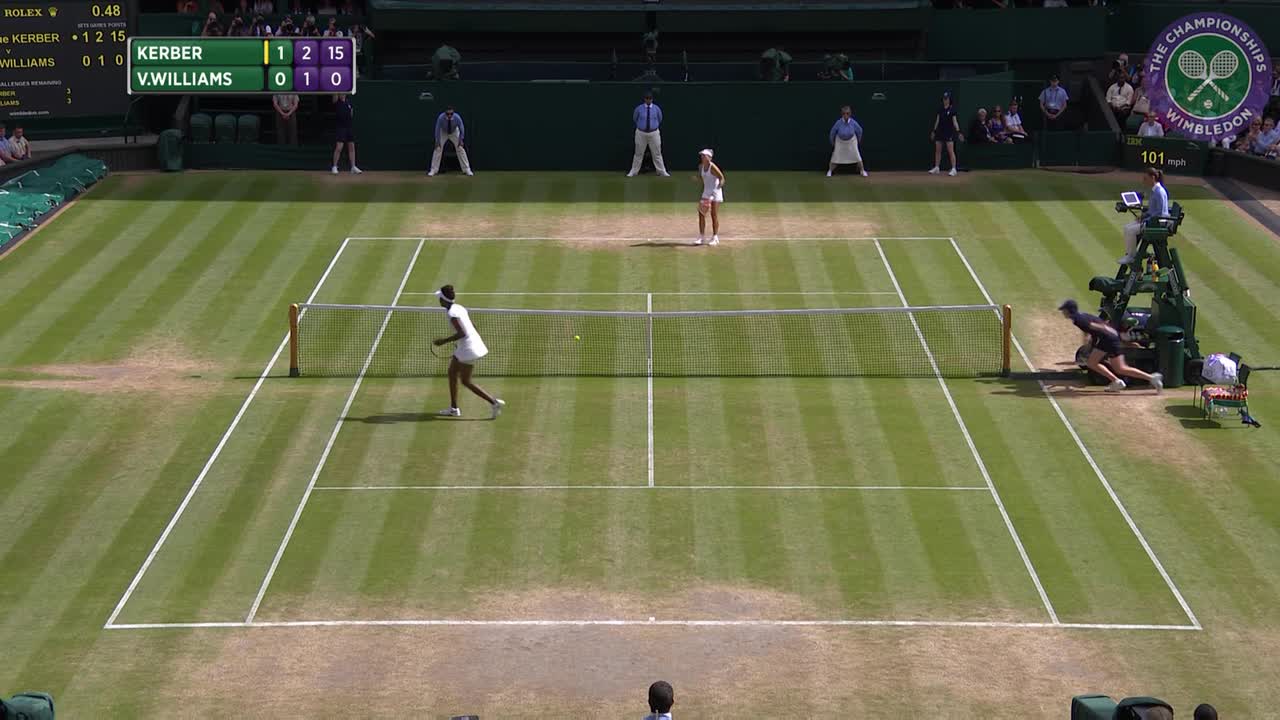An hour or so into her semi-final against Venus Williams on Thursday, Angelique Kerber was up a set and a break, 3-2, and serving.
In theory, she was right where she wanted to be, but she had a funny way of showing it. Kerber opened the game with two double faults to go down 0-30. A commentator in the BBC booth wondered if the “nerves are about to show” as the 28-year-old German tried to reach her first Wimbledon final in nine tries.
Kerber didn’t appear to wonder at all. She backed off the baseline, shook out her left (serving) arm, and fired one of her two aces of the afternoon. On the next point, at 15-30, she smacked a service winner, and she held from there. Kerber’s nerves may have shown for a minute, but that was the last we saw of them. She maintained her one-break lead over Venus, and finished the match with one of the shots of the tournament, a forehand pass that she pulled back across her body, and past Venus at the net.
When Kerber saw the ball dip over the net for a winner, she briefly knelt down in celebration, but there were no theatrics, and no sense of surprise.

As the reigning Australian Open champion, she knows she belongs in these matches, and on these stages. “Just amazing,” Kerber said afterwards of her last shot, her trip to Saturday's final, and the way she feels about her game.
Kerber didn’t always feel, or act, as if she belonged in the final weekends of major events. She was a late bloomer who only crossed most fans’ radars when she made an unseeded run to the semi-finals at the US Open in 2011, a year in which she had lost in the first round at the three previous Grand Slams. As 2016 began, that result had begun to look fluky; in the five years since, Kerber had been back to a Slam semi just once, at Wimbledon in 2012. Kerber’s defensive-minded game and soft second serve worked better at mid-level events; the biggest tournaments were reserved for the biggest hitters.
Kerber changed all of that, of course, when she beat Serena Williams in the third set of the Australian Open final.

Afterwards, though, she had her ups and downs; between January and June, Kerber lost in the first round five times. Did she struggle with the closer scrutiny and increased expectations? Did she believe she belonged at the top of the rankings? Kerber said she put too much pressure on herself at the French Open, where she lost her opener to eventual semi-finalist Kiki Bertens.
At Wimbledon, though, Kerber has been a different player, on court and in the interview room. She hasn’t dropped a set in six matches, and she has done it by being more proactive than at any time I can remember.
While her serve still isn’t imposing - Kerber was broken nine times in her last two matches combined - she’s hurting her opponents with her returns, spreading the court with her sharp angled ground strokes, and pulling the tirgger with her forehand down the line as soon as she can.
On Thursday, Kerber did a good job of forcing Venus to move in one direction and then the other, and finding her weaker forehand. “I’m trying to play my game, trying to be aggressive,” Kerber has said numerous times during the Fort-night. She seems to believe, more than ever, that her natural game is an attacking game. After her semi-final win, Kerber said she was telling herself to “go for every shot.”
That assertiveness, and her comfort with it, has carried over to Kerber’s off-court pronouncements. She’s feeling confident, and she’s not afraid who knows it. “I’m playing really good tennis right now,” she said after her quarter-final win over Simona Halep. “I’m playing like in Australia, really high class tennis.”
“It’s not my first semis,” she said as she looked forward to playing Venus. Her self-assured tone made you believe that the word “semis” could have been replaced with “rodeo”.
At the same time, Kerber’s confidence hasn’t turned into a counterproductive perfectionism on court.
Wimbledon Finals! Unbelievable… Let’s make this a perfect day! #DieMannschaft #Wimbledon #TeamAngie pic.twitter.com/0QlYz30bwv
— Angelique Kerber (@AngeliqueKerber) July 7, 2016
In the past, a few mistakes from her could lead to many more, as her frustration mounted and her attitude deteriorated; in her worst moments, she seemed to play tennis sarcastically. Not this fortnight. While Kerber has had her serve broken regularly, she hasn’t let it keep her from breaking right back.
All of this is good news for women’s tennis. The WTA has seen a series of towering but temporary waves sweep across it in 2016: First Kerber won in Australia, then Victoria Azarenka won the Indian Wells-Miami double, then Garbiñe Muguruza won the French Open. Each time we wondered if a challenger for Serena had stepped forward; each time we watched that potential challenger retreat again.
Now Kerber is riding her second wave, right into another Grand Slam final with Serena. We’ll see if she can surf it all the way in again.
